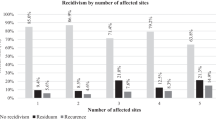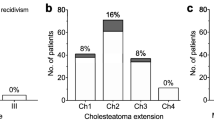Abstract
Purpose
In cholesteatoma recidivism, achieving satisfactory hearing outcome after revision surgery remains challenging. The presence of concomitant recidivism pathology or related anatomical abnormalities can impact revision reconstruction of the sound transmission system. The current study aimed to identify prognostic factors affecting hearing outcomes after surgery for cholesteatoma recidivism.
Methods
This retrospective cohort study included consecutive patients whose ears required initial surgery for recidivism between January 2016 and December 2021. Patients followed up for < 6 months and those not indicated for ossiculoplasty were excluded. The impact of preoperative otoscopic findings, computed tomography (CT) features, and hearing levels on the prediction of satisfactory hearing (postoperative air–bone gap [ABG] ≤ 20 dB) was evaluated using univariate and multivariate logistic regression analyses.
Results
Overall, 102 patients were included, with a mean follow-up of 24.8 months. Multivariate logistic regression analysis revealed the following independent predictive factors for satisfactory hearing: presence of aeration in the tympanic cavity (odds ratio [OR] [95% confidence interval {CI}]: 13.287 [1.113–158.604], p = 0.0409), absence of soft-tissue density occupying the oval window (OR [95% CI]: 13.445 [3.178–56.887], p = 0.0040), and ≤ 22.5 dB preoperative ABG in four-frequency average (OR [95% CI]: 9.339 [2.026–43.050], p = 0.0042).
Conclusions
For cholesteatoma recidivism, reliable preoperative prediction based on CT and ABG would facilitate decision-making regarding the probability of efficient revision ossiculoplasty or appropriate preoperative counseling, including early hearing rehabilitation using hearing aids or implementation of simultaneous implantable hearing equipment during surgery for recidivism.



Similar content being viewed by others
Data availability
The data that support the findings of this study are available on request from the corresponding author. The data are not publicly available owing to privacy or ethical restrictions.
References
Mishiro Y, Sakagami M, Kitahara T, Kondoh K, Okumura S (2008) The investigation of the recurrence rate of cholesteatoma using Kaplan-Meier survival analysis. Otol Neurotol 29:803–806. https://doi.org/10.1097/MAO.0b013e318181337f
Syms MJ, Luxford WM (2003) Management of cholesteatoma: status of the canal wall. Laryngoscope 113:443–448. https://doi.org/10.1097/00005537-200303000-00010
Neudert M, Lailach S, Lasurashvili N, Kemper M, Beleites T, Zahnert T (2014) Cholesteatoma recidivism: comparison of three different surgical techniques. Otol Neurotol 35:1801–1808. https://doi.org/10.1097/MAO.0000000000000484
Presutti L, Gioacchini FM, Alicandri-Ciufelli M, Villari D, Marchioni D (2014) Results of endoscopic middle ear surgery for cholesteatoma treatment: a systematic review. Acta Otorhinolaryngol Ital 34:153–157
Cho YS, Hong SD, Chung KW, Hong SH, Chung WH, Park SH (2010) Revision surgery for chronic otitis media: characteristics and outcomes in comparison with primary surgery. Auris Nasus Larynx 37:18–22. https://doi.org/10.1016/j.anl.2009.01.014
Li S, Meng J, Zhang F, Li X, Qin Z (2016) Revision surgery for canal wall down mastoidectomy: intra-operative findings and results. Acta Oto-laryngol 136:18–22. https://doi.org/10.3109/00016489.2015.1092170
Veldman JE, Braunius WW (1998) Revision surgery for chronic otitis media: a learning experience. Report on 389 cases with a long-term follow-up. Ann Otol Rhinol Laryngol 107:486–491. https://doi.org/10.1177/000348949810700606
Kaylie DM, Gardner EK, Jackson CG (2006) Revision chronic ear surgery. Otolaryngol Head Neck Surg 134:443–450. https://doi.org/10.1016/j.otohns.2005.10.044
Bhatia S, Karmarkar S, DeDonato G et al (1995) Canal wall down mastoidectomy: causes of failure, pitfalls and their management. J Laryngol Otol 109:583–589. https://doi.org/10.1017/s0022215100130798
Motegi M, Yamamoto Y, Ouchi K et al (2020) The impact of middle ear aeration on surgical outcome after intact canal wall tympanoplasty for cholesteatoma. Auris Nasus Larynx 47:965–975. https://doi.org/10.1016/j.anl.2020.06.006
Demir E, Atsal G, Yildirim O et al (2019) Anatomical and frequencies-specific hearing results of retrograde mastoidectomy. Am J Otolaryngol 40:372–376. https://doi.org/10.1016/j.amjoto.2019.02.005
Whittemore KR Jr, Merchant SN, Rosowski JJ (1998) Acoustic mechanisms: canal wall-up versus canal wall-down mastoidectomy. Otolaryngol Head Neck Surg 118:751–761. https://doi.org/10.1016/S0194-5998(98)70264-5
Dornhoffer JL, Gardner E (2001) Prognostic factors in ossiculoplasty: a statistical staging system. Otol Neurotol 22:299–304. https://doi.org/10.1097/00129492-200105000-00005
Kaffenberger TM, Govil N, Shaffer AD, Chi DH (2018) Prognostic factors of pediatric revision ossicular chain reconstruction. Otol Neurotol 39:724–731. https://doi.org/10.1097/MAO.0000000000001837
Yung M, Tono T, Olszewska E et al (2017) EAONO/JOS Joint consensus statements on the definitions, classification and staging of middle ear cholesteatoma. J Int Adv Otol 13:1–8. https://doi.org/10.5152/iao.2017.3363
Tono T, Sakagami M, Kojima H et al (2017) Staging and classification criteria for middle ear cholesteatoma proposed by the Japan Otological Society. Auris Nasus Larynx 44:135–140. https://doi.org/10.1016/j.anl.2016.06.012
AAO (1995) Committee on Hearing and Equilibrium guidelines for the evaluation of results of treatment of conductive hearing loss. American Academy of Otolaryngology-head and Neck Surgery Foundation, Inc. Otolaryngol Head Neck Surg 113:186–187. https://doi.org/10.1016/S0194-5998(95)70103-6
Albu S, Babighian G, Trabalzini F (1998) Prognostic factors in tympanoplasty. Am J Otol 19:136–140
De Vos C, Gersdorff M, Gérard JM (2007) Prognostic factors in ossiculoplasty. Otol Neurotol 28:61–67. https://doi.org/10.1097/01.mao.0000231598.33585.8f
Martin TP, Weller MD, Kim DS, Smith MC (2009) Results of primary ossiculoplasty in ears with an intact stapes superstructure and malleus handle: inflammation in the middle ear at the time of surgery does not affect hearing outcomes. Clin Otolaryngol 34:218–224. https://doi.org/10.1111/j.1749-4486.2009.01929.x
Bared A, Angeli SI (2010) Malleus handle: determinant of success in ossiculoplasty. Am J Otolaryngol 31:235–240. https://doi.org/10.1016/j.amjoto.2009.02.014
Jackler RK, Schindler RA (1984) Role of the mastoid in tympanic membrane reconstruction. Laryngoscope 94:495–500. https://doi.org/10.1288/00005537-198404000-00013
Haginomori S, Takamaki A, Nonaka R, Mineharu A, Kanazawa A, Takenaka H (2009) Postoperative aeration in the middle ear and hearing outcome after canal wall down tympanoplasty with soft-wall reconstruction for cholesteatoma. Otol Neurotol 30:478–483. https://doi.org/10.1097/MAO.0b013e31819e634a
Ikeda M, Yoshida S, Ikui A, Shigihara S (2003) Canal wall down tympanoplasty with canal reconstruction for middle-ear cholesteatoma: post-operative hearing, cholesteatoma recurrence, and status of re-aeration of reconstructed middle-ear cavity. J Laryngol Otol 117:249–255. https://doi.org/10.1258/00222150360600823
Shinnabe A, Hara M, Hasegawa M et al (2011) Relationship between postoperative aeration around the stapes and postoperative hearing outcome after canal wall down tympanoplasty with canal reconstruction for cholesteatoma. Otol Neurotol 32:1230–1233. https://doi.org/10.1097/MAO.0b013e31822f0b88
Merchant SN, McKenna MJ, Mehta RP, Ravicz ME, Rosowski JJ (2003) Middle ear mechanics of Type III tympanoplasty (stapes columella): II. Clinical studies Otol Neurotol 24:186–194. https://doi.org/10.1097/00129492-200303000-00010
Rosowski JJ, Merchant SN (1995) Mechanical and acoustic analysis of middle ear reconstruction. Am J Otol 16:486–497
Shinnabe A, Hara M, Hasegawa M et al (2012) Differences in middle ear ventilation disorders between pars flaccida and pars tensa cholesteatoma in sonotubometry and patterns of tympanic and mastoid pneumatization. Otol Neurotol 33:765–768. https://doi.org/10.1097/MAO.0b013e318254fb85
Russell JS, Cox MD, Anderson SR, Dornhoffer JL (2015) Pediatric cartilage tympanoplasty with primary intubation. Otol Neurotol 36:453–456. https://doi.org/10.1097/MAO.0000000000000694
Cinamon U, Sadé J (2003) Mastoid and tympanic membrane as pressure buffers: a quantitative study in a middle ear cleft model. Otol Neurotol 24:839–842. https://doi.org/10.1097/00129492-200311000-00002
Merchant SN, Ravicz ME, Rosowski JJ (1997) Mechanics of type IV tympanoplasty: experimental findings and surgical implications. Ann Otol Rhinol Laryngol 106:49–60. https://doi.org/10.1177/000348949710600110
Tumarkin A (1957) On the nature and vicissitudes of the accessory air spaces of the middle ear. J Laryngol Otol 71:65–99. https://doi.org/10.1017/s0022215100051598
Black B (1992) Ossiculoplasty prognosis: the SPITE method of assessment. Am J Otol 13:544–551
Mishiro Y, Sakagami M, Kitahara T, Kondoh K, Kubo T (2008) Long-term hearing outcomes after ossiculoplasty in comparison to short-term outcomes. Otol Neurotol 29:326–329. https://doi.org/10.1097/MAO.0b013e31816166ce
Acknowledgements
None.
Funding
No funding was received for conducting this study.
Author information
Authors and Affiliations
Contributions
Concept: MM; design: MM, YY; supervision: HK; resource: TN, SK, MT, SS, KY; materials: TT, MH; data collection and/or processing: MM; analysis and/or interpretation: MM; literature search: MM; writing: MM: critical reviews: YY.
Corresponding author
Ethics declarations
Conflict of interest
The authors have no relevant financial or non-financial interests to disclose. The authors alone are responsible for the content and writing of the manuscript.
Ethical approval
Approval was obtained from the institutional review board of The Jikei University School of Medicine (approval number: 32-205[10286]). The procedures used in this study adhere to the tenets of the Declaration of Helsinki.
Consent to participate
The requirement for informed consent was waived owing to the retrospective nature of the study.
Additional information
Publisher's Note
Springer Nature remains neutral with regard to jurisdictional claims in published maps and institutional affiliations.
Rights and permissions
Springer Nature or its licensor (e.g. a society or other partner) holds exclusive rights to this article under a publishing agreement with the author(s) or other rightsholder(s); author self-archiving of the accepted manuscript version of this article is solely governed by the terms of such publishing agreement and applicable law.
About this article
Cite this article
Motegi, M., Yamamoto, Y., Nakazawa, T. et al. Radiological and audiological prediction for hearing outcome in cholesteatoma recidivism surgery. Eur Arch Otorhinolaryngol 280, 2715–2724 (2023). https://doi.org/10.1007/s00405-022-07760-6
Received:
Accepted:
Published:
Issue Date:
DOI: https://doi.org/10.1007/s00405-022-07760-6




